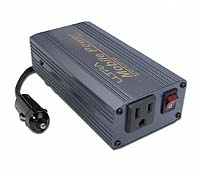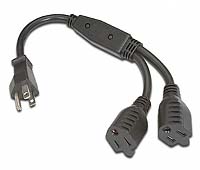12/06 Staying Charged on the Road
The combination of car travel, camping and digital photography have an Achilles heel — you run out of juice. A digital SLR battery lasts a day or two, but theyíre vital so you carry a couple back-ups. The cell lasts about the same, but, not vital, so no back-up there. Worst is the laptop that drains in about two hours, so about the time you get your photos downloaded and start an edit, itís hibernate time. A spare laptop battery is expensive, and you need the laptop not just to edit but burn back-up CDís. So how to survive a week or more of car camping?

Ultra 150w DC/AC inverter
Many photographers on such an outing spend a lot of time in the car, driving between locations or scouting the next shoot, so charging in the car is an option. A few Brobdingnag SUVís have built-in AC outlets, but God-help-us, donít go out and buy one of those. Most camera or electronic gear manufacturers offer cigarette-lighter type charging adapters — just plug in and charge. Youíll most likely need one for each battery-powered device, though, and some cost over $100. My low-cost alternate solution is a DC-to-AC inverter with AC outlet that plugs into the lighter. If you need more than one outlet, add a $5 splitter (see pictures).

Ultra SJT Powercord Splitter
I have to say I thought this was inelegant, converting car battery DC power to a chopped 120v AC, only to convert it back to DC when you plug in your chargers. I went this route, though, with a 150-watt inverter, and splitter, at a cost of $50. You can do better by shopping the net. The 150 watts is plenty to keep two chargers going, and kept me juiced during a week-long car-camp trip. A model worth a look is the Ultra 150-watt DC/AC inverter and, to double your capability, their SJT Powercord Splitter.
There are other routes to back-up power, especially useful for extended kayak trips. I'll look at those in an upcoming Kayak Camera Sea Photo Tip.
Gary
Also see FAQ for on-the-water advice.
